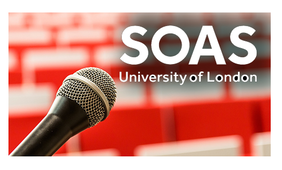Professor Anne Pauwels (SOAS University of London) hâldt op woansdeitemiddei 3 maaie in lêzing oer 'Exploring multilingual soundscapes in the city' yn it gebou fan de Fryske Akademy yn Ljouwert. Jo binne fan herte wolkom. De lêzing sil yn it Ingelsk wêze en is fergees tagonklik. Graach oanmelde fia de e-mail! It begjint om 15:30 oere, nei ôfrin binne jo útnûge foar in hapke en drankje. De abstract (gearfetting) fan it ûndersyk dêr't Pauwels oer fertelle sil, stiet hjirûnder.
Oer Anne Pauwels (Ingelske biografy)
Anne Pauwels is Professor of Sociolinguistics at SOAS University of London (School of Oriental and African Studies). Pauwels was Head of the College of Arts and Law at the University of Birmingham and before that she worked for nearly 30 years in Australian Universities including the Universities of Western Australia, Wollongong, New England and Monash.
Her first degree was in Germanic Philology, University of Antwerp (Belgium). She gained an MA and a PhD from Monash University, Australia. Her dissertations were concerned with questions of language contact and multilingualism in Australia. She held the Foundation Chair of Linguistics at the University of New England and in 1995 she was elected Fellow of the Academy of the Social Sciences in Australia [FASSA].
Her research deals with the social and sociolinguistic aspects of language and communication, with particular attention to multilingual and transnational settings. Her main research foci include multilingualism, language maintenance/shift, language policy in relation to language learning in schools and universities as well as various aspects of the relationship between gender and language.
Mear oer Pauwels en har ûndersykswurk is te lêzen op har persoanlike pagina op de SOAS website.
Gearfetting
In the past two to three decennia the study of multilingualism has not only expanded but also been reconceptualised, often linked to “new” approaches and theories about the concept of language, i.e. what constitutes a language. The latter has given rise to a discourse about language that focuses on fluidity rather than separateness leading to concepts and terms such as translanguaging, crosslingual, interlinguality and languaging, among others. With regard to the former – the expansion of the field– the subject of linguistic landscapes is an important one (e.g., Landry & Bourhis 1997; Gorter 2006). The study of linguistic landscapes involves the visual documentation of multilingualism in public domains and spaces such as on street signs, official and/or public notices, billboards, announcements, advertising material, shop signs, etc. The visual documentation of multilingualism (or its absence) enhances our view and understanding of linguistic diversity and its complexity beyond the private sphere. When studied diachronically, it also provides a good insight into linguistic changes, for example, which languages appear and disappear from the landscape, attitudinal changes towards public multilingualism (e.g.,tolerance vs intolerance). To my knowledge, an important and relevant aspect of public multilingualism that has not yet received much attention is the documentation of multilingual soundscapes in public spaces, e.g., on the street, on public transport, in waiting rooms, at the market, in shops and ‘eating’ places. Given the centrality of the study of sound and oral language in linguistic research, it is perhaps surprising that soundscapes have not yet received the attention that linguistic landscapes have in documenting linguistic diversity. The methodological complexity surrounding collecting data about soundscapes is undoubtedly a reason: there are many technical, ethical, and indeed linguistic issues that ‘hamper’ collection. Equipment to record and extract linguistic sounds from a multitude of sounds and noises in public places needs to be quite sophisticated. There are the ethical issues of recording voices surreptitiously (seeking individual consent is not possible or practical). Of course, then there is the question of being able to identify all the languages, although that is of lesser concern given the more recent developments of language recognition software and access to linguistic colleagues able to identify the languages. Despite these obstacles I decided to undertake some pilot studies to delve into this fascinating area of research. My first foray into documenting multilingual soundscapes has been limited to ethnographic observations in two multilingual cities – Melbourne (Australia) and Antwerp (Belgium) – the former my current place of residence, and the latter my birth and hometown. In this presentation I will discuss some of the methodological hurdles facing soundscape research as well as give a more detailed report of pilot studies in these two cities.
References
Landry, R. & Bourhis, R. (1997) Linguistic landscape and ethnolinguistic vitality: an empirical study. Journal of language and social psychology Vol 16: 23-49.
Gorter, D. (ed.) (2006) Linguistic landscape: A new approach to the study of multilingualism. Clevedon: Multilingual Matters.



